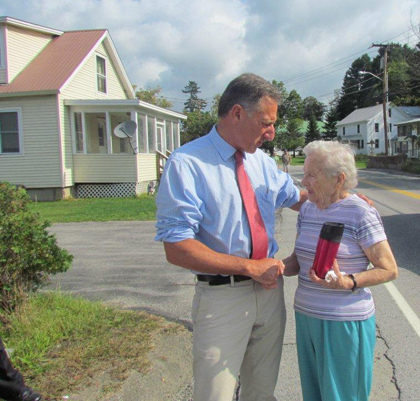
Federal, state and local agencies and non-governmental organizations are joining forces to better understand and address vulnerabilities and lessons learned from Tropical Storm Irene in the Mad River Valley.
Several of these agencies and organizations joined a meeting of the Mad River Valley Planning District to discuss the effort on August 16 in Waitsfield, where members from the collaborative group outlined their initiative to build on existing efforts geared toward improving flood resilience in the Mad River watershed.
The group plans to implement and deploy resources from two federal programs; the America’s Great Outdoors (AGO) program and the Smart Growth Implementation Assistance (SGIA) planning initiative.
The U.S. Fish and Wildlife Service, U.S. Forest Service and U.S. Department of Agriculture are providing federal leadership in the AGO program. The Vermont Agency of Natural Resources, which attracted the federal support by working with the Department of the Interior, has recently completed a Winooski River watershed management plan, which includes the Mad River watershed.
The federal and state agencies and non-governmental organizations were attracted to the Mad River Valley because of the watershed-wide work that local groups and towns have already contributed toward flood resilience and natural resource conservation.
The Friends of the Mad River, the Mad River Valley Planning District, the Vermont Land Trust and the Winooski Natural Resources Conservation District coordinated many of the local efforts. The partners hope the Mad River Valley effort can be replicated throughout the state.
In a complimentary effort under SGIA, the U.S. Environmental Protection Agency and Vermont Department of Economic, Housing and Community Development are working with communities in the Mad River Valley on a long-term flood recovery and statewide resiliency planning initiative to develop guidance that can help flood-prone municipalities adopt a wide range of strategies for avoiding further damage to investments and improving safety.
Strategies will involve short-term measures like flood-proofing buildings as well as long-term efforts such as conserving land to give rivers more room to move and store floodwaters. Communities in the Mad River Valley watershed will be the focus of this study and what is learned there will be applied statewide. Recommendations will be available by the end of 2012.
At the Mad River Valley Planning District meeting on August 16, the group discussed the process for improved planning for flood resilience. The process includes reducing conflict between built infrastructure and rivers. In addition, resilience-focused land management practices could reduce or slow the force of the floodwaters by infiltrating surface runoff before it reaches streams, slowing down flows by encouraging the reforestation of areas in the flood plains and adequately sizing and placing culverts to allow for predicted larger flows.
The flood resiliency projects that AGO partners are assisting the Mad River Valley with this year include tree planting in riparian buffers, encouraging the use of cover crops and planting practices that keep agricultural soils vegetated and replacing culverts inadequate for floodwaters as well as aquatic organism passage.
In addition, AGO partners are supporting community efforts to conserve parcels from future development through the purchase of conservation easements. The federal, state and local partners are poised to assist the communities within the watershed through on-the-ground projects, helping to identify vulnerabilities to long-term flood recovery and to integrate lessons learned from Tropical Storm Irene into on-going plans and policies.
In addition, the Mad River Valley Planning District will be embarking on a Mad River Valley hill farm research and community engagement project through the fall and winter months. This effort, underwritten by the Vermont Division for Historic Preservation, seeks to better understand the significant role that land use patterns have had on the local environment and explore future agricultural opportunities outside of flood prone locations.
“We want to ensure that communication with the surrounding towns is at the forefront as we move toward the goal of community resiliency in the face of future flooding,” said Mad River Valley Planning District director Joshua Schwartz. “This community has been through a lot in the past year – we came together to deal with the problems that Tropical Storm Irene created, and now we will come together in hopes of finding some solutions for mitigating future flood events,” Schwartz concluded.
“When Vermonters work together to implement projects that reduce the risk of flood damage to our communities, farms and businesses, we are investing in a better future,” said Agency of Natural Resources Secretary Deb Markowitz, “a future that also includes healthier and cleaner rivers and lakes.”
She continues, “I am excited to see the America’s Great Outdoors initiative in the Mad River Valley is bringing government at all levels together with citizens, farms and businesses to establish great projects which will serve as a model for other communities across Vermont.”
{loadnavigation}






